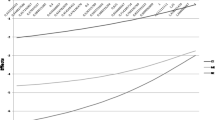Abstract
In several member states of the European Union, collective bonus reserves are set up as part of the statutory reserves backing traditional participating life insurance business. Although primarily reserved for policyholders’ future surplus participation, national law (for example in Germany and Austria) allows the insurance companies to use these funds to (partly) cover future losses. Under the risk-based solvency framework Solvency II, the loss absorbency of these buffer reserves is explicitly recognized by so-called surplus funds which are classified as Basic Own Funds. This paper performs a profound analysis of the approach currently used in Germany to reflect this type of risk sharing between policyholders and shareholders in the Solvency II framework. The comprehensive methodology developed in this paper can be used to determine the economic value of surplus funds and ensures that no double-counting of future cash flows occurs. It can easily be adapted to other countries, in particular Austria. Based on a stochastic balance sheet and cash flow projection model, we present numerical results that illustrate how the allowance for Surplus Funds affects Basic Own Funds, Solvency Capital Requirement, Risk Margin and Deferred Taxes under Solvency II. We conclude that the current valuation approach appears to be internally consistent, but some of the underlying assumptions are questionable. In particular, the valuation approach should be refined in order to better reflect local statutory requirements, including both, accounting rules and other regulatory constraints for participating business.







Similar content being viewed by others

Notes
Notice that also longer declaration periods are possible, i.e. policyholders’ surplus participation is declared several years in advance.
Note that currently there exists a temporary exception to be applied for assessment years 2016 and 2017 which extends this period to 5 years (cf. § 34 KStG).
For more details concerning the definition of SCR see Christiansen and Niemeyer [4].
See Führer and Grimmer [8], p. 112.
For technical reasons we assume that the death of a policyholder always occurs at the end of the year.
For details see Burkhart et al. [3].
Note that BaFin allows for a calculation based on those withdrawals as an approximation for the amount of SF if certain requirements are fulfilled.
Premiums and costs do not depend on the scenario.
Minor adjustments may be necessary, e. g. to reflect lapse fees in case of surrender.
Note that our approach to use the BEL before deduction of SF is in line with the calculation of the duration factor in the BSM. We are aware of the fact that the choice of drivers for SCR projection is an important aspect in the calculation of the RM. However, an in-depth analysis is beyond the scope of this paper and is left for future research.
References
BaFin (2015)Interpretative Decisions –Überschussfonds nach Art. 91 der Solvency-II-Richtlinie. https://www.bafin.de/SharedDocs/Downloads/DE/Auslegungsentscheidung/dl_ae_151204_ueberschussfonds.pdf?_blob=publicationFile&v=7. Accessed on 29 Jan 2016
BaFin (2016)Interpretative Decisions—Latente Steuern auf versicherungstechnische Rückstellungen unter Solvency II. http://www.bafin.de/SharedDocs/Veroeffentlichungen/ DE/Auslegungsentscheidung/VA/ae_160222_latente_steuern_auf_versicherungstechnische_rueckstellungen.html. Accessed on 11 Apr 2016
Burkhart T, Reuß A, Zwiesler HJ (2015) Participating life insurance contracts under Solvency II: inheritance effects and allowance for a Going Concern Reserve. Eur Actuar J 5(2):203–244
Christiansen MC, Niemeyer A (2014) Fundamental definition of the solvency capital requirement in solvency II. ASTIN Bull 44(03):501–533
DAV (2011) DAV Fachgrundsatz—market consistent embedded value. Cologne
European Commission (2015) Commission Delegated Regulation (EU) 2015/35. Brussels
European Union (2009) Directive 2009/138/EC of the European Parliament and of the Council of 25 November 2009 on the taking-up and pursuit of the business of Insurance and Reinsurance (Solvency II). OJ L 335/1
Führer C, Grimmer A (2010) Einführung in die Lebensversicherungsmathematik, 2nd edn. Verl. Versicherungswirtschaft, Karlsruhe
GDV (2008) GDV-Rundschreiben 2359/2008 – Anwendung von Aufsichtsregeln in der Finanzmarktkrise. Berlin
GDV (2015) Die deutsche Lebensversicherung in Zahlen 2015. http://www.gdv.de/wp-content/uploads/2015/07/GDV-Lebensversicherung-in-Zahlen-2015.pdf. Accessed on 13 June 2016
GDV (2016) Fachkonzept Branchensimulationsmodell. Berlin
Glasserman P (2010) Monte Carlo methods in financial engineering. Springer, New York, NY
Goecke O (2013) Pension saving schemes with return smoothing mechanism. Insur Math Econ 53(3):678–689
Hansen M, Miltersen KR (2002) Minimum rate of return guarantees: the Danish case. Scand Actuar J 2002(4):280–318
Kling A, Richter A, Ruß J (2007) The interaction of guarantees, surplus distribution, and asset allocation in with-profit life insurance policies. Insur Math Econ 40(1):164–178
Reuß A, Ruß J, Wieland J (2015) Participating life insurance contracts under risk based solvency frameworks: how to increase capital efficiency by product design. In: Glau K, Scherer M, Zagst R (eds) Innovations in Quantitative Risk Management. Springer Proceedings in Mathematics & Statistics, Vol 99. Springer, Cham, pp 185–208
Wagner T (2013) Solvency II: surplus funds und going-concern-reserve. Der Aktuar 2013(2):71–74
Wolfsdorf K (1997) Versicherungsmathematik: Teil 1: Personenversicherung. Vieweg + Teubner Verlag, Stuttgart
Author information
Authors and Affiliations
Corresponding author
Appendix
Appendix
See Table 10.
Rights and permissions
About this article
Cite this article
Burkhart, T., Reuß, A. & Zwiesler, HJ. Allowance for surplus funds under Solvency II: adequate reflection of risk sharing between policyholders and shareholders in a risk-based solvency framework?. Eur. Actuar. J. 7, 51–88 (2017). https://doi.org/10.1007/s13385-017-0147-1
Received:
Revised:
Accepted:
Published:
Issue Date:
DOI: https://doi.org/10.1007/s13385-017-0147-1



